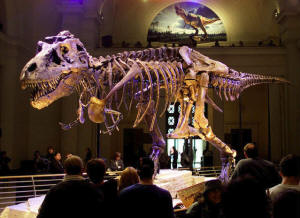|
Revolutionary overhaul of dinosaur family
tree proposed
 Send a link to a friend
Send a link to a friend
 [March 24, 2017]
By Will Dunham [March 24, 2017]
By Will Dunham
WASHINGTON (Reuters) - Some of the
best-known dinosaurs, like Tyrannosaurus rex and Brontosaurus, may be
headed for a divorce due to irreconcilable differences.
Scientists on Wednesday proposed a radical overhaul of the dinosaur
family tree first laid out in 1888, concluding after an analysis of 75
species that the meat-eating group that includes T. rex should not be
lumped in with the long-necked, long-tailed, four-legged plant-eaters
like Brontosaurus.
The proposed new family tree includes two reformulated categories, or
clades, of dinosaurs to replace the two that paleontologists have long
recognized. The research also pushes dinosaur origins back to relatively
soon after a mass extinction that rocked the Earth 252 million years
ago.
"We may be proved to be correct, we may not," said University of
Cambridge paleontologist Matthew Baron, who led the research published
in the journal Nature.

"But what has to happen now is a complete abandonment of old dogmatic
views across the field because we have shown that rigorous and objective
studies can pull apart age-old ideas, and that we as scientists should
never got too comfortable with an idea when it can still be tested in
new ways."
Key skeletal differences indicate the meat-eating group called
theropods, including giants like T. rex, Allosaurus, Giganotosaurus and
Spinosaurus, and the long-necked group called sauropods, including huge
Brontosaurus, Diplodocus and Argentinosaurus, should not be banded
together, he said.
Scientists long have organized dinosaurs into two clades.
The so-called bird-hipped Ornithischia includes the herbivorous
spiky-tailed stegosaurs, tank-like ankylosaurs, horned dinosaurs,
duckbills and dome-headed dinosaurs. The so-called reptile-hipped
Saurischia covered theropods including birds and the sauropods.
[to top of second column] |

The dinosaur named "Sue," a 41-foot-long Tyrannosaurus rex, is shown
on display at the Field Museum in Chicago, U.S. on May 17, 2000.
REUTERS/Sue Ogrocki/File Photo

Baron proposed two newly devised categories. The first, called
Ornithoscelida, joins the theropods with all the current members of
Ornithischia. The current Saurischia group would lose the theropods
but add a strange, primitive group of two-legged carnivores called
herrerasaurids.
The analysis placed the earliest dinosaur at 242 to 247 million
years ago, a small Tanzanian species called Nyasasaurus. After
humble beginnings, dinosaurs become the dominant land animals until
an asteroid wiped them out 66 million years ago.
"Our results strongly suggest that the ancestral dinosaur was a
quick, two-footed, generalist feeder that would have eaten a mix of
plants and meat," Baron said.
University of Maryland paleontologist Thomas Holtz, not involved in
the study, praised the research, saying, "There is a very good
chance that they are correct, even though it goes against decades of
research pointing a different way."
(Reporting by Will Dunham; Editing by Sandra Maler)
[© 2017 Thomson Reuters. All rights
reserved.]
Copyright 2017 Reuters. All rights reserved. This material may not be published,
broadcast, rewritten or redistributed.
 |